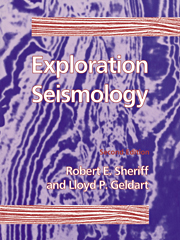Book contents
- Frontmatter
- Contents
- Preface
- Mathematical conventions and symbols
- 1 Introduction
- 2 Theory of seismic waves
- 3 Partitioning at an interface
- 4 Geometry of seismic waves
- 5 Seismic velocity
- 6 Characteristics of seismic events
- 7 Equipment
- 8 Reflection field methods
- 9 Data Processing
- 10 Geologic interpretation of reflection data
- 11 Refraction methods
- 12 3-D Methods
- 13 Specialized techniques
- 14 Specialized applications
- 15 Background mathematics
- Appendices
- Index
9 - Data Processing
Published online by Cambridge University Press: 05 June 2012
- Frontmatter
- Contents
- Preface
- Mathematical conventions and symbols
- 1 Introduction
- 2 Theory of seismic waves
- 3 Partitioning at an interface
- 4 Geometry of seismic waves
- 5 Seismic velocity
- 6 Characteristics of seismic events
- 7 Equipment
- 8 Reflection field methods
- 9 Data Processing
- 10 Geologic interpretation of reflection data
- 11 Refraction methods
- 12 3-D Methods
- 13 Specialized techniques
- 14 Specialized applications
- 15 Background mathematics
- Appendices
- Index
Summary
Overview
The “digital revolution” changed seismic exploration beginning in the early 1960s, about 20 years before the widespread use of CDs in recorded music. The changes were of the same kind: much less noise, no deterioration of signal by repeated processing (playing), and the ability to reshape the information content into more easily understood forms.
Radar, one of the technological advances of World War II, was used in detecting ships and aircraft. However, noise frequently interfered with its application and considerable theoretical work devoted to the detection of signals in the presence of noise led to the development of a new field of mathematics, information theory. At first, this theory was very difficult to understand because it was formulated in complex mathematical expressions and employed an unfamiliar vocabulary. However, the development of digital computer technology considerably simplified the understanding of the basic concepts, and the number of applications has expanded greatly.
Early in the 1950s, a research group at the Massachusetts Institute of Technology studied the application of information theory to seismic exploration (Flinn, Robinson, and Treitel, 1967). These studies combined with the new digital technology changed seismic exploration considerably. Today, most seismic data are recorded in digital form and subjected to data processing before being interpreted.
The basic concepts are expressed in a number of books and papers (Lee, 1960; Robinson and Treitel, 1964, 1980; Silverman, 1967; Anstey, 1970; Finetti, Nicolich, and Sancin, 1971; Kanasewich, 1987).
- Type
- Chapter
- Information
- Exploration Seismology , pp. 275 - 348Publisher: Cambridge University PressPrint publication year: 1995
- 1
- Cited by



